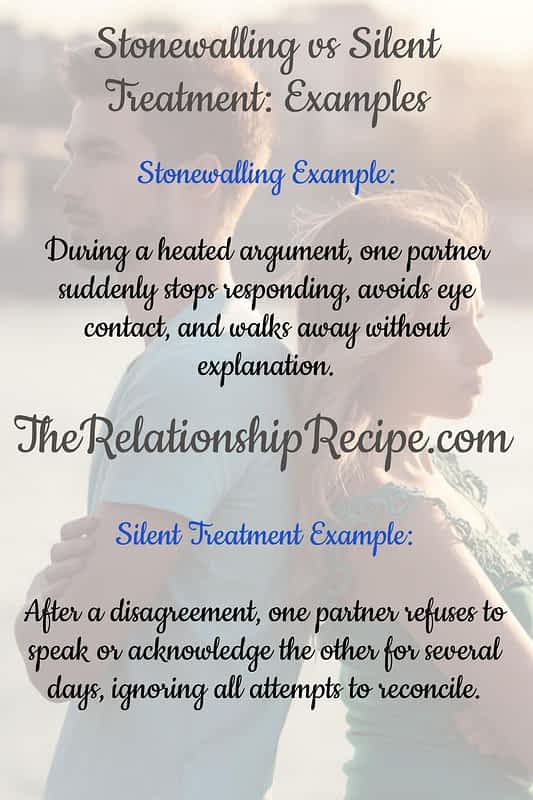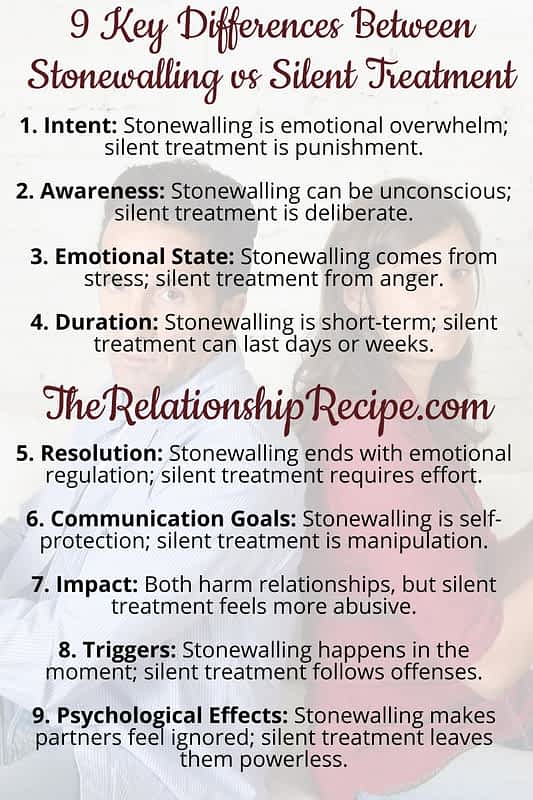Stonewalling vs Silent Treatment: 9 Big Differences to Know
You’re sitting across from your partner, the silence between you thick enough to slap. Earlier, they stonewalled you by shutting down completely during your argument. Now, hours later, you’re caught in the classic stonewalling vs silent treatment showdown.
You try to break the ice, but they don’t even glance up, lost in their own world. It feels like you don’t exist, and no matter what you say or do, the cold silence sticks around like an unwanted guest.
So here you are, stuck and confused, wondering what to do and whether you should keep pushing or just walk away.
While both are mildly infuriating, they come from two totally different places.
Today, we’ll do a deep dive into the difference between stonewalling vs silent treatment, why it happens, and how to deal with both.
💡Key Highlights
- The subtle but powerful intentions behind communication shutdowns.
- What separates emotional overload from emotional control.
- How silence can speak volumes and damage trust.
- Eye-opening emotional effects you might not see coming.
- Tactics that help you respond with clarity instead of confusion.

I’ve been on the receiving end of both stonewalling and silent treatment and it left me feeling all kinds of confused. Stonewalling sucks because it looks like getting totally ignored on purpose.
But the silent treatment was actually a relief from nonstop arguing. I didn’t even care that he thought he was “punishing” me.
After decades of marriage, you learn to let stuff like this roll off your back like water off a duck. But if you’re in a fresh relationship, I get how seriously frustrating and hurtful this can be.
Whether it’s stonewalling or the silent treatment, reacting this way during a fight doesn’t do your relationship any favors. It just breeds hurt feelings and resentment. People use these two terms interchangeably all the time – but they’re not the same. Different motives, different effects, and very different outcomes.

The Differences Between Stonewalling and Silent Treatment
🚩Stonewalling Signs in Couples
Stonewalling happens when one person in the relationship just checks out emotionally in the middle of a conversation. Instead of actually talking things through, they go radio silent by refusing to respond, or even acknowledge, their partner’s attempts to connect.
It’s basically avoidance on steroids. The stonewaller completely shuts down, leaving the other person feeling ignored, frustrated, and honestly, kind of helpless.
👉Most of the time, this behavior comes from feeling totally overwhelmed or just not knowing how to handle the emotional mess the conversation’s stirring up. Rather than facing the problem head-on, they slam the door on any interaction, making it near impossible to actually fix anything or move forward.

🚩What is the Silent Treatment in Relationships?
The silent treatment is like stonewalling’s annoying cousin, but with a twist. While stonewalling usually happens in the heat of the moment, the silent treatment drags on, often as a deliberate, drawn-out ignoring game.
When someone throws the silent treatment your way, they’re flat-out refusing to talk, even when it’s clear that some communication or resolution is needed.
👉This move is usually less about being overwhelmed and more about punishment or straight-up manipulation. The person dishing out the silent treatment wants to control the story, making you feel small, invisible, or totally unimportant. It’s a classic power play that leaves the other person stuck in a rough spot..

Stonewalling vs Silent Treatment: Examples
💔Stonewalling Example:
- During a heated argument, one partner suddenly stops responding, avoids eye contact, and walks away without explanation.
💔Silent Treatment Example:
- After a disagreement, one partner refuses to speak or acknowledge the other for several days, ignoring all attempts to reconcile.

Stonewalling or Silent Treatment? Key Differences Between the Two
🚩1. Intent:
Stonewalling signs in couples usually pops up when someone feels totally overwhelmed; think stress, anxiety, or just drowning in emotions. They shut down as a way to protect themselves from getting even more emotionally drained.
On the flip side, the silent treatment is way more calculated. It’s a straight-up power move, used to punish or manipulate. Someone giving the silent treatment is deliberately ghosting their partner to get back at them or steer the situation their way.
Knowing the difference between stonewalling and silent treatment isn’t just relationship 101… it’s survival mode. They might both look like someone just disappearing on you, but one’s a “I’m overwhelmed, please don’t drown me” vibe, and the other’s a “You messed up, so I’m ignoring you on purpose” power play. Getting this straight can save you a lot of headache (and eye-rolling) down the road.
🚩2. Awareness:
Stonewalling often sneaks up on people like an emotional autopilot because they don’t even realize they’re shutting down in the middle of a heated moment. It’s more about self-preservation than some sneaky scheme.
The silent treatment is a totally different beast. It’s a fully planned move, like a chess player thinking three steps ahead. The person using it knows exactly what they’re doing and the emotional punch it’ll pack. They’re basically saying, “I’m shutting you out on purpose, and yeah, it hurts.”
The difference between stonewalling and silent treatment gets real obvious when it comes to awareness. One’s an accidental shutdown, the other’s a full-on, calculated blackout and it’s important to acknowledge how the silent treatment affects relationships as the damage can be incalculable. That’s why knowing if someone is giving you stonewalling or silent treatment can help you figure out if you’re dealing with someone overwhelmed or someone playing emotional games.

🚩3. Emotional State:
Stonewalling usually kicks in when stress or anxiety hit hard; think emotional overload. The person pulls back because they just can’t handle the heat and need a timeout, often without even realizing it. It’s their brain’s way of saying, “Nope, not today.”
The silent treatment is more about anger and resentment. When someone’s feeling burned or wronged, they throw up the silent wall like it’s a dramatic mic drop, using silence as their way to say, “I’m mad, and you’re gonna feel it.”.
When you break down the difference between stonewalling and silent treatment, it’s clear they don’t just come from the same place. One’s a stressed-out shutdown; the other’s a calculated cold shoulder. Spotting the triggers helps you know what kind of drama you’re actually dealing with.
🚩4. Duration:
Stonewalling usually shows up as a short-term thing, popping up during moments of intense stress. Once the storm passes and the person calms down, you can usually get back to talking like normal.
The silent treatment, on the other hand, likes to stick around for the long haul. We’re talking days, weeks, or even longer. That’s because it’s a calculated move: a drawn-out punishment or power play designed to keep you guessing and feeling stuck.
When you look at the difference between stonewalling and silent treatment, their timelines couldn’t be more different. One’s a quick emotional shutdown, the other’s a cold, slow burn, and knowing that can save you from wasting time on endless silence.

🚩5. Resolution:
Resolution with stonewalling usually happens once the emotional storm has passed and the person feels safe enough to jump back into the conversation. It often just takes a little time to cool off before things can get back on track.
The silent treatment – that one’s way tougher to fix. It needs the person dishing it out to decide they’re done playing games and actually want to talk again. Meanwhile, the person on the receiving end often has to jump through hoops just to get a single word, and that kind of dynamic only widens the emotional gap.
When you compare the difference between stonewalling and silent treatment, how they get resolved shows a lot about what’s really going on. One’s about calming down and reconnecting, the other’s about control and conditions, (as well as being extremely emotionally immature) and that can make all the difference in whether a relationship heals or just drags on.
🚩6. Communication Goals:
Stonewalling is all about self-preservation. When someone feels emotionally overwhelmed, they pull back to avoid saying something they’ll regret or to dodge more conflict. It’s their way of pressing pause and protecting their fragile emotional state.
The silent treatment, on the other hand, is a power and control move. It’s a deliberate strategy to punish, manipulate, and make the other person squirm by guilt-tripping them into feeling small, uncertain, or desperate for attention. It’s all about control, plain and simple.
When you start seeing the comparisons between stonewalling or silent treatment, their intentions couldn’t be more different. One’s a defense mechanism trying to keep peace, the other’s a calculated power play meant to mess with your head.

🚩7. Impact:
Both stonewalling and the silent treatment can seriously damage relationships, but how silent treatment affects relationships tends to be way more brutal and long-lasting. Since the silent treatment is a deliberate power move, it feels downright abusive – and it is- because it’s designed to emotionally hurt, isolate, and confuse the other person.
Stonewalling, while still painful, usually comes off as a temporary emotional shutdown, not some calculated emotional weapon. The silent treatment leaves scars; stonewalling just leaves you hanging.
🚩8. Triggers:
Stonewalling usually pops up right in the heat of things, when emotions are running wild and someone just feels totally overwhelmed by the conversation or situation. It’s an instant “I can’t deal with this right now” kind of reaction.
The silent treatment tends to come after someone feels wronged – like they’ve been hurt, disrespected, or just plain ticked off by something their partner did. This silence isn’t accidental – it’s planned – to make the other person squirm over whatever offense sparked it.
🚩9. Psychological Effects:
Stonewalling usually leaves the other person feeling ignored or brushed off like their concerns don’t matter and their partner just checked out emotionally. It’s frustrating, but at least there’s a chance the wall will come down.
The silent treatment cuts way deeper. It makes you feel worthless, powerless, and like you’re stuck in emotional quicksand, questioning if you even matter at all. Since it drags on, it’s not just them ignoring you it’s straight-up emotional invalidation that can make you wonder if the whole relationship is a joke.

Impact of Stonewalling vs the Silent Treatment on the Relationship
Both stonewalling or silent treatment can seriously mess with your relationship, but they do it in their own “special” ways. Stonewalling can slam the brakes on any conversation, leaving everything stuck and making it impossible to move forward.
Silent treatment is a whole different level of emotional manipulation. It’s designed to make the other person feel guilty, insecure, and downright lousy about themselves. When it comes to stonewalling vs silent treatment, knowing how they impact conflict resolution can save you a lot of drama and heartache.
🚀The long-term effects of stonewalling vs silent treatment are significant. Stonewalling may lead to unresolved issues and stifle emotional intimacy, while the silent treatment can create long-term emotional rifts, causing feelings of abandonment or flat-out rejection.

How to Address Stonewalling or Silent Treatment in Your Relationship
Now that we’ve explored the differences between stonewalling vs silent treatment, let’s look at how to deal with these behaviors in a relationship.
✔️1. Acknowledge the Behavior
First things first: you’ve got to be able to spot when stonewalling or the silent treatment is happening. Calling out these behaviors is the only way to start fixing the mess and actually heal.
If you’re seeing signs of stonewalling, give your partner some breathing room to cool off, but don’t let them ghost forever. Make it clear you want to talk when they’re ready.
Now, if the silent treatment is their go-to move, speak up about how it’s making you feel and set some serious boundaries. And for goodness’ sake – don’t chase after them or beg for their attention. That’s exactly what they want, and all you’ll do is teach them to keep playing games for whatever their weird little desired result is.

✔️2. Communicate Openly
Communication is the secret sauce for tackling stonewalling or silent treatment in any relationship. You’ve got to build a space where you can both speak your minds without feeling like you’re about to get judged or iced out.
That also means digging into the real emotional stuff underneath: like what’s making someone shut down or go radio silent in the first place. Because if you don’t deal with the root cause, you’re just slapping a Band-Aid on a leaky pipe.

✔️3. Seek Therapy if Needed
If stonewalling or the silent treatment keep popping up like a bad habit in your relationship, it might be time to call in the pros. A good therapist or relationship counselor can help you both untangle the communication mess and figure out healthier ways to handle conflict without all the emotional disappearing acts.

✔️4. Set Boundaries
Setting clear boundaries is absolutely necessary when you’re dealing with stonewalling vs silent treatment. You’ve got to lay it out plainly: emotional disappearing acts and cold shoulders aren’t an acceptable way to handle conflict. Period.
Instead, talk about healthier ways to hit pause, like taking a break to cool off, doing some deep breathing so you don’t say something you’ll regret, or agreeing to sit down for a calm chat once you’ve both had a chance to chill out. Because let’s face it, anything beats the endless awkward silence and emotional mind games.

Final Thoughts On Stonewalling and How Silent Treatment Affects Relationships
The difference between stonewalling vs silent treatment might look subtle on the surface, but knowing exactly what you’re dealing with can seriously level up how you handle communication in your relationship.
Obviously, both behaviors can build walls, crank up the emotional distance, and make conflict resolution feel like an Olympic sport. But with a little awareness, some patience, and a lot of honest conversation, you can get through it.
At the end of the day, whether you’re dealing with a stressed-out shutdown or a calculated cold shoulder, the secret sauce for a healthy relationship is simple: open dialogue, mutual respect, and a genuine effort to understand each other’s emotional needs without all the silent drama.

FAQ: Stonewalling vs Silent Treatment in Relationships
1. What’s the difference between stonewalling vs silent treatment?
Stonewalling vs silent treatment: Stonewalling is emotional withdrawal due to stress, while the silent treatment is a deliberate act used to punish or control someone.
2. Is stonewalling or silent treatment intentional?
In stonewalling vs silent treatment, stonewalling is often unconscious, a reaction to emotional overwhelm, while the silent treatment is a conscious decision to withhold communication and cause emotional harm.
3. How long does the silent treatment last compared to stonewalling or silent treatment?
In the stonewalling vs silent treatment comparison, stonewalling is usually short-term and resolves once emotions calm, while the silent treatment can last for days, weeks, or even longer.
4. Why does someone give the silent treatment in stonewalling vs silent treatment?
The silent treatment in stonewalling vs silent treatment is used to punish, control, or manipulate, while stonewalling is a response to emotional stress or overwhelm that shuts down communication.
5. Can stonewalling or silent treatment hurt a relationship?
Yes, both stonewalling or silent treatment can harm relationships, but the silent treatment is often more damaging due to its deliberate and punitive nature, leaving the other person feeling devalued.
6. How do stonewalling or silent treatment affect communication?
In stonewalling vs silent treatment, stonewalling temporarily halts communication due to emotional overwhelm, while the silent treatment intentionally stops communication to punish or manipulate the other person.
7. What triggers stonewalling vs silent treatment?
Stonewalling or silent treatment can be triggered differently. Stonewalling happens when someone feels emotionally overwhelmed. The silent treatment is triggered by anger, resentment, or perceived offense.
8. How does stonewalling vs silent treatment affect emotions?
In stonewalling vs silent treatment, stonewalling leaves partners feeling ignored or dismissed, while the silent treatment makes them feel devalued, powerless, and uncertain in the relationship.
This post may contain affiliate links. I earn from qualifying Amazon purchases at no extra cost to you. This content is for informational purposes only and is not a substitute for professional advice. [Read full disclaimer.]
Thank you for reading this post, don't forget to subscribe!







